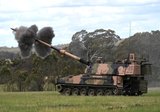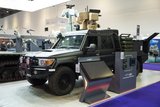First Lockheed Martin EQ-36 counterfire target acquisition radars deployed
The US Army recently deployed the first Lockheed Martin Enhanced AN/TPQ-36 (EQ-36) counterfire target acquisition radar systems in Iraq and Afghanistan.
A new advanced radar for the Army, EQ-36 systems have the ability to detect, classify, track and locate enemy indirect fire such as mortars, artillery and rockets in either 360- or 90-degree modes. The new systems will supplement and eventually replace legacy AN/TPQ-36 and AN/TPQ-37 medium-range radars now in the Army's inventory.
"From the start, the EQ-36 program has been about the soldier and the Army's urgent need to protect them from daily indirect fire threats," said Carl Bannar, vice president of Lockheed Martin's Radar Systems. "With more than 40-years of radar experience, we developed the EQ-36 radar in fewer than 30 months -- less than half the time it traditionally takes to develop a new radar system."
In July 2009, Lockheed Martin delivered the first two EQ-36 systems to the Army, ahead of schedule, following successful live-fire field testing at Yuma Proving Grounds in Arizona.
Lockheed Martin was awarded the original contract in January 2007 by the Army's Program Executive Office, Intelligence, Electronic Warfare and Sensors.Lockheed Martin is teamed with SRC, of Syracuse, N.Y., on the EQ-36 program.
Source: Lockheed Martin
More from Digital Battlespace
-
![Babcock nears first customer for Nomad AI translation tool]()
Babcock nears first customer for Nomad AI translation tool
Nomad can provide militaries with real-time intelligence, saving critical time on the battlefield.
-
![AUSA 2025: Israel’s Asio Technologies to supply hundreds of improved Taurus tactical systems]()
AUSA 2025: Israel’s Asio Technologies to supply hundreds of improved Taurus tactical systems
Taurus operates alongside the Israel Defense Forces’ Orion system which supports mission management across tens of thousands of manoeuvring forces, from squad leaders to battalion commanders.
-
![AUSA 2025: Kopin pushes micro-LED plans as China moves faster]()
AUSA 2025: Kopin pushes micro-LED plans as China moves faster
The plan for the new displays follows fresh investment in Kopin’s European facilities by Theon and an order for head-up displays in fielded aircraft, with funding from the US Department of Defense.
-
![AUSA 2025: Persistent Systems to complete its largest order by year’s end]()
AUSA 2025: Persistent Systems to complete its largest order by year’s end
Persistent Systems received its largest ever single order for its MPU5 devices and other systems earlier this month and has already delivered the 50 units to the US Army’s 4th Infantry Division.
-
![Aselsan brings in dozens of companies and systems under the Steel Dome umbrella]()
Aselsan brings in dozens of companies and systems under the Steel Dome umbrella
Turkey has joined the family of countries attempting to establish a multilayered air defence system with government approval in August 2024 for the effort landed by Aselsan. Dubbed Steel Dome, the programme joins Israel’s Iron Dome, the US Golden Dome, India’s Mission Sudarshan Chakra and South Korea’s low-altitude missile defence system.
-
![DSEI 2025: MARSS unveils new agnostic multidomain C4 system]()
DSEI 2025: MARSS unveils new agnostic multidomain C4 system
MARSS’ NiDAR system has been deployed using sensors from static platforms to provide detection and protection for static sights, such as critical infrastructure, ports and military bases.




























